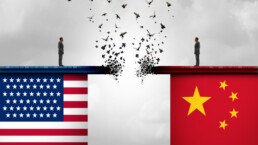The U.S. and China are still treading on the precipice of a major conflict. Can they put that in the past?
by Michael Klare, Tom Dispatch
This hasn’t exactly been a year of good news when it comes to our war-torn, beleaguered planet, but on November 15th, U.S. President Joe Biden and Chinese President Xi Jinping took one small step back from the precipice. Until they talked in a mansion near San Francisco, it seemed as if their countries were locked in a downward spiral of taunts and provocations that might, many experts feared, result in a full-blown crisis, even a war — even, god save us all, the world’s first nuclear war. Thanks to that encounter, though, such dangers appear to have receded. Still, the looming question facing both countries is whether that retreat from disaster — what the Chinese are now calling the “San Francisco vision” — will last through 2024.
Prior to the summit, there seemed few discernible obstacles to some kind of trainwreck, whether a complete breakdown in relations, a disastrous trade war, or even a military clash over Taiwan or contested islands in the South China Sea. Beginning with last February’s Chinese balloon incident and continuing with a series of bitter trade disputes and recurring naval and air incidents over the summer and fall, events seemed to be leading with a certain grim inevitability toward some sort of catastrophe. After one such incident last spring, New York Times columnist Thomas Friedman warned that “the smallest misstep by either side could ignite a U.S.-China war that would make Ukraine look like a neighborhood dust-up.”

In recent months, top leaders in both Beijing and Washington were becoming ever more concerned that a major U.S.-China crisis — and certainly a war — would prove catastrophic for all involved. Even a major trade war, they understood, would create economic chaos on both sides of the Pacific. A complete breakdown in relations would undermine any efforts to come to grips with the climate crisis, prevent new pandemics, or disrupt illegal drug networks. And a war? Well, every authoritative nongovernmental simulation of a U.S.-China conflict has ended in staggering losses for both sides, as well as a significant possibility of nuclear escalation (and there’s no reason to assume that simulations conducted by the American and Chinese militaries have turned out any differently).
Recent Posts
Ecuador Rejects Foreign Military Bases
November 17, 2025
Take Action Now People of Ecuador 1 — Military Industrial Complex 0By David Swanson, World BEYOND War In 2007, then-President of Ecuador Rafael…
Step Down, Chuck, A Zero Hour Conversation With Sam Rosenthal
November 17, 2025
Take Action Now “People are starving for a real, visible fight against Trumpism—and Schumer isn’t delivering it.”By RJ Eskow and Sam Rosenthal,…
Wilson in Seattle and Mamdani in New York Back Starbucks Workers Strike
November 16, 2025
Take Action Now “I am not buying Starbucks and you should not either.” By Jon Queally, Common Dreams The mayors-elect in both Seattle and…
‘The Trump Administration Needs to Be Isolated in Its Anti-Science Actions’: CounterSpin interview with Rachel Cleetus on climate complicity
November 16, 2025
Take Action Now Janine Jackson interviewed the Union of Concerned Scientists’ Rachel Cleetus about climate complicity for the October 31, 2025,…




